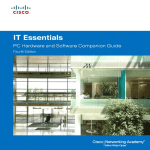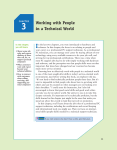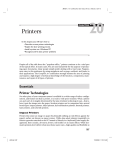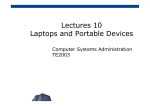Download Installing, Configuring, and Troubleshooting Windows Vista
Transcript
Installing, Configuring, and Troubleshooting Windows Vista At the end of the course the delegate will be able to complete the following: COMPUTER TRAINING Installing Windows Vista The key to a better future WINDOWS Course No. 5115 3 Days Skills: Target Audience: This course provides students with the knowledge and skills to install, configure, and troubleshoot Windows Vista desktops. It is intended for IT Professionals that are responsible for deploying desktop operating systems, provisioning desktop computers, and deploying service packs and updates to these computers, and who wish to become technology specialists. Pre-requisites: Before attending this course, students must have the following pre-requisites: • Familiarity with PC hardware and devices. • Basic TCP/IP knowledge. • Basic Windows and Active Directory knowledge. • Experience with mapping network file shares. • Experience with running commands from a command window. • Experience with reviewing BIOS settings. • Technical knowledge equivalent to the following courses: CompTIA A+ Essentials, CompTIA A+ (220-602), CompTIA Network+ (2009 objectives). Purpose: After completing the course, students will be able perform a clean installation of Windows Vista and migrate user-related data and settings from Windows XP; configure the post-installation settings of a computer running Windows Vista; configure and manage disks, partitions, and volumes on a computer installed with Windows Vista; manage files and printing in Windows Vista; configure and troubleshoot network connectivity; configure a wireless network connection; configure and troubleshoot Windows Vista security; optimize and maintain performance and reliability in Windows Vista; configure mobile computers and devices; configure Windows Vista productivity applications. This module explains how to install and configure Windows Vista. It introduces the various editions and features of Windows Vista, and the module also describes how to upgrade or migrate to Windows Vista. Introduction to Windows Vista Preparing to Install Windows Vista Performing a Clean Installation of Windows Vista Upgrading or Migrating from a Previous Version of Windows Upgrading Between Windows Vista Editions Lab: Installing Windows Vista Describe the new features and editions of Windows Vista. Describe the various hardware, driver, and disk requirements for installing Windows Vista. Perform a clean installation of Windows Vista. Migrate to Windows Vista from earlier versions of Windows. Upgrade between Windows Vista Editions. Managing Files and Printers on Windows Vista Systems Skills: This module explains how to configure the post-installation settings of a Windows Vista installation. It describes how to configure computer settings, device drivers, system properties, accessibility features, and Windows Aero. Configuring Computer Settings Installing and Configuring Device Drivers Configuring System Properties Configuring Accessibility Features Configuring Windows Aero Lab: Configuring Post-Installation Settings Skills: Configure basic computer settings. Install and configure device drivers. Configure system properties, including system protection and remote settings. Configure accessibility features. Enable and configure Windows Aero. Configuring Disks on Windows Vista Systems This module explains how to configure disks on Windows Vista systems. It describes how to partition disks, manage disk volumes and file system fragmentation. It also explains how to configure disk quotas. Partitioning Disks in Windows Vista Managing Disk Volumes Managing File System Fragmentation Configuring Disk Quotas Lab: Configuring Disks on Windows Vista Systems Skills: Configure disk partitions. Create and manage disk volumes. Manage file system fragmentation. Configure disk quotas. Manage shared folders. Manage file access in Windows Vista. Configure file compression. Install, configure and administer printers. Configuring Network Connectivity Configuring Post-Installation Settings This module explains how to manage files, shared folders, and printing on Windows Vista systems. It also explains how to configure file compressions. Managing Shared Folders Managing File Access Configuring File Compression Managing Printing Lab: Managing Files and Printing on Windows Vista Systems This module explains how to configure IPv4 and IPv6 network connectivity. It also describes how to configure automatic IP address allocation and remote access. In addition, the module explains how to troubleshoot network issues. Configuring IPv4 Network Connectivity Configuring IPv6 Network Connectivity Implementing Automatic IP Address Allocation Troubleshooting Network Issues Configuring Remote Access Lab: Configuring Network Connectivity Skills: Configure IPv4 network connectivity. Configure IPv6 connectivity. Implement automatic IP address allocation in Windows Vista. Troubleshoot network issues by using built-in tools in Windows Vista. Configure remote access by enabling Remote Desktop and Remote Assistance features. Configuring Wireless Network Connections This module provides an overview of wireless networks, and it describes how to connect to a wireless network. Overview of Wireless Networks Connecting to a Wireless Network Lab: Configuring Wireless Network Connections Skills: Describe the standards and technologies related to wireless network connections. Describe the hardware and the process involved in connecting to a wireless network. Configuring Windows Vista Security This module explains how to configure the security features in Windows Vista. It describes how to configure Windows Security Center, Windows Firewall with Advanced Security, Windows Defender, and Internet Explorer. The module also describes how to secure a Windows Vista computer by using group policy settings and User Account Control. Configuring Windows Security Center Configuring Windows Firewall with Advanced Security Configuring Windows Defender Configuring Security Settings in Internet Explorer 7.0 Securing a Windows Vista Computer by Using Local Group Policy Settings Configuring and Troubleshooting User Account Control Lab: Configuring Windows Vista Security Skills: Configure Windows Security Center. Configure Windows Firewall with Advanced Security. Configure Windows Defender to help protect against malicious software. Configure security-related settings in Internet Explorer to help protect a Vista computer that is online. Secure a Windows Vista computer by using local Group Policy settings. Configure and troubleshoot User Account Control settings. Optimizing and Maintaining Performance and Reliability in Windows Vista This module explains how to optimize and maintain performance and reliability in Windows Vista systems by using built-in tools. It describes how to use the built-in performance and diagnostic tools in Windows Vista. The module also describes how to perform backup and restore operations and to configure Windows Update. Maintaining Performance by Using the Windows Vista Performance Tools Maintaining Reliability by Using the Windows Vista Diagnostic Tools Backing Up and Restoring by Using Windows Backup Creating and Managing System Restore Points Configuring Windows Update Lab: Optimizing and Maintaining Performance and Reliability in Windows Vista Skills: Configure mobile computer settings. Configure mobile devices by implementing sync partnerships. Configure power options by using power plans. Configure Tablet PC settings. Configuring Windows Vista Productivity Applications This module explains how to configure the various productivity applications in Windows Vista including Windows Sidebar, Windows Mail, Windows Meeting Space, Windows Calendar, and Windows Fax and Scan. Configuring Windows Sidebar Configuring Windows Mail Configuring Window Meeting Space Configuring Windows Calendar Configuring Windows Fax and Scan Skills: Configure Windows Sidebar. Configure Windows Mail. Configure Windows Meeting Space. Configure Windows Calendar. Configure Windows Fax and Scan. F1 COMPUTER TRAINING SERVICES THE KEY TO A BETTER FUTURE for further information… call us on 0800 169 1890 F1 COMPUTING SYSTEMS LTD 3 Kelso Place Upper Bristol Road BATH BA1 3AU Fax: 01225 444728 [email protected] www.f1comp.co.uk LONDON BATH OR ONSITE Skills: Maintain performance by using the Windows Vista performance tools. Maintain reliability by using the Windows Vista diagnostic tools. Perform backup and restore operations. Create and manage System Restore Points. Configure Windows Update. PARTICULARS Configuring Mobile Computers and Devices Cost: £1185 plus VAT This module explains how to configure mobile computer and device settings in Windows Vista. It also describes how to configure power options and Tablet PC settings. Configuring Mobile Computer Settings Configuring Mobile Devices Configuring Power Options Configuring Tablet PC Settings Lab: Configuring Mobile Computers and Devices Prices are subject to change without prior notice. Please see the course page on www.f1comp.co.uk, or call 01225 336096, to verify the current price of this course. Numbers: Maximum of 6 people on each course at F1’s training facilities in London and Bath Supporting Windows Vista and Applications in the Enterprise At the end of the course the delegate will be able to complete the following: COMPUTER TRAINING Installing Windows Vista in an Enterprise Environment The key to a better future WINDOWS Course No. 5118 5 Days Target Audience: This course provides students with the knowledge and skills to support the Windows Vista operating system and applications in the Enterprise. It is intended for enterprise-level IT professionals who focus on a broad range of desktop operating system, desktop application, mobile device, networking, and hardware support issues. Pre-requisites: Before attending this course, students must have the following pre-requisites: • Experience installing Windows operating systems. • Experience running commands from a command window. • Familiarity with hardware and devices. • Basic TCP/IP knowledge. • Basic networking knowledge. • Basic Windows and Active Directory knowledge. • Application fundamentals, such as how a client communicates with the server in client/server applications. • Experience reviewing logs. Purpose: After completing the course, students will be able to install Windows Vista in an Enterprise; describe and troubleshoot the Windows Vista boot process; configure and troubleshoot network connections; manage Windows Vista desktop systems; manage user profiles and data for Windows Vista portable and desktop computers; maintain and monitor Windows Vista performance and health; configure and troubleshoot Windows Vista Security feature settings; configure security settings to protect data on Windows Vista desktops; configure security for Windows Vista networks; configure Windows Vista to support remote users; troubleshoot operating system and application issues; troubleshoot hardware on Windows Vista computers; manage applications using Group Policy. This module describes the methods used to install Windows Vista in an Enterprise environment. Preparing for Windows Vista Deployment Backing Up the User State Automating a Windows Vista Installation Creating and Deploying Images Windows Deployment Services Overview Lab: Preparing for Vista Deployment Lab: Deploying Windows Vista Skills: Configuring and Managing User Data and Profiles Skills: Prepare for Windows Vista deployment. Back up the User State. Automate a Windows Vista installation. Create and deploy images. Describe Windows Deployment Services (WDS). Troubleshooting the Windows Vista Boot Process and System Services This module describes how to troubleshoot the Windows Vista boot process. Windows Vista Recovery Environment Overview Configuring and Troubleshooting Startup Settings Troubleshooting Operating System Services Lab: Configuring and Troubleshooting the Windows Vista Startup Process Skills: Describe the Windows Vista startup process and recovery options. Configure and troubleshoot startup settings. Troubleshoot operating system services. Troubleshooting Networks This module explains how to configure and troubleshoot network connections. Determining Network Settings Troubleshooting Network Connections Lab: Troubleshooting Networks Skills: Obtain information to help troubleshoot your networks. Explain how to use the Network Diagnostics Framework to troubleshoot network problems. Managing Windows Vista Desktop Systems This module describes how to identify and perform tasks to manage Windows Vista desktop systems. Windows Vista Desktop Management Overview Group Policy in Windows Vista Using Group Policy to Manage Desktops and Applications Using Group Policy Preferences to Manage Windows Vista Troubleshooting Group Policy Windows Remote Management Service Lab: Planning and Configuring Group Policy Lab: Managing Windows Vista Desktop Systems Describe desktop management. Describe Group Policy in Windows Vista. Use Group Policy to configure desktops and applications. Manage Windows Vista using Preferences. Troubleshoot Group Policy. Use WinRM to configure remote computers. This module explains how to manage user profiles and data for Windows Vista portable and desktop computers. Windows Vista User Profiles Overview Implementing Folder Redirection Configuring Offline Profiles Working with Shadow Copies Lab: Configuring and Managing User Data Profiles Skills: Describe user profiles in Windows Vista. Implement folder redirection. Configure offline files. Enable and configure shadow copies. Maintaining and Monitoring Windows Vista Desktops This module explains how to perform tasks to maintain and optimize Windows Vista performance and health. Maintaining Software Updates Monitoring Reliability and Performance Event Viewer Overview Configuring Windows Task Scheduler Lab: Maintaining and Monitoring Windows Vista Desktops Skills: Configure software. Use the Performance and Reliability Monitor. Use Event Viewer. Configure Windows Task Scheduler. Securing Windows Vista Desktops This module describes how to configure and troubleshoot Windows Vista security settings. Windows Vista Security Overview Configuring User Account Control Troubleshooting Authentication Issues Implementing Windows Defender Securing Internet Explorer Configuring Antivirus with Microsoft Forefront Lab: Securing Windows Vista Desktops Skills: Describe the Windows Vista security features. Configure and troubleshoot User Account Control settings. Troubleshoot the authentication process. Configure Windows Defender to help protect against malicious software. Configure security-related settings in Windows Internet Explorer 7. Configure Microsoft Forefront to provide antivirus protection. Securing Data on Windows Vista This module describes different methods for providing security for data on Windows Vista desktops. Using Permissions to Share and Secure Data Configuring EFS Configuring BitLocker Drive Encryption Lab: Securing Data on Windows Vista Skills: Describe how to secure and share data using permissions. Configure the Encrypting file Systems (EFS). Configure Windows BitLocker Drive Encryption. Securing Windows Vista Networks This module explains how to configure security for Windows Vista networking. Network Access Protection Overview Securing Wireless Networks Implementing Windows Firewall Configuring IPsec Lab: Securing Windows Vista Networks F1 COMPUTER TRAINING SERVICES THE KEY TO A BETTER FUTURE Skills: Describe Network Access Protection (NAP). Secure a wireless network. Implement Windows Firewall. Configure Internet Protocol security (IPsec). Supporting Remote Users This module explains how to configure remote access methods. Configuring VPN Connections Using Remote Desktop Using Remote Assistance Lab: Supporting Remote Users Skills: Configure VPN connections. Use Remote Desktop. Use Remote Assistance. Troubleshooting Operating System and Application Installations This module explains how to perform troubleshooting techniques related to the operating system and applications. Troubleshooting the Operating System Troubleshooting the Application Installation Lab: Troubleshooting Operating System and Application Installations for further information… call us on 0800 169 1890 F1 COMPUTING SYSTEMS LTD 3 Kelso Place Upper Bristol Road BATH BA1 3AU Fax: 01225 444728 [email protected] www.f1comp.co.uk LONDON BATH OR ONSITE Skills: Identify and use operating system troubleshooting techniques. Identify and use application installation troubleshooting techniques. Troubleshooting Hardware This module explains how to troubleshoot hardware failures. Troubleshooting Hardware Overview Troubleshooting Physical Failures Troubleshooting Device Driver Failures Troubleshooting Printing in Windows Vista Lab: Troubleshooting Hardware Skills: Identify basic hardware-related issues. Determine problems related to hardware failures. Determine problems that are caused by device drivers. Identify the recovery options for computers protected by BitLocker. PARTICULARS Cost: £1750 plus VAT Prices are subject to change without prior notice. Please see the course page on www.f1comp.co.uk, or call 01225 336096, to verify the current price of this course. Numbers: Maximum of 6 people on each course at F1’s training facilities in London and Bath











